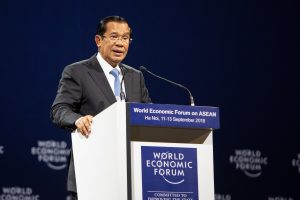Cambodia’s future in ASEAN has become a topic of debate once more due to recent commentary arguing that the kingdom’s position in Southeast Asia’s leading multilateral institution has been compromised owing to its relationship with China. Some have even argued that it might be time for Cambodia to be excluded from ASEAN in light of its mooted role as a “proxy state.” We reject this contention.
ASEAN is structured around three pillars: the ASEAN Political-Security Community (APSC), the ASEAN Economic Community (AEC) and the ASEAN Socio-Cultural Community (ASCC). ASEAN’s Political Security Blueprint has defined the framework for cooperation in political-security development across the region, and it has served as a crucial means of offsetting risks and uncertainties. On the political-security front, Cambodia has indeed scored relatively low in comparison to other states. However, that score does not tell the entire story of Cambodia’s security history in ASEAN. After all it was Phnom Penh that in 2008 and 2011, when confronting the dispute over Preah Vihear temple, sought ASEAN’s intervention, while Bangkok opted for bilateral negotiation.
We recognize that lingering sentiments from prior dialogue over the South China Sea question have created suspicion about Cambodia’s position within the ASEAN family of nations. However, the expulsion of Cambodia from ASEAN is neither an effective nor a practical solution for either entity. Rather than casting Cambodia to one side, it is necessary to begin the process of rebuilding strategic trust while the kingdom itself needs to present more effectively its core values such that a stronger set of shared, collective interests can be generated and serve as a basis for future cooperation and confidence-building.
At the same time, viewing ASEAN’s mission entirely or even predominantly through the lens of politics and security and adjudicating membership based on a single pillar requires an overly narrow and highly distinct interpretation of the institution and its mission. On the other two pillars, economics and socio-cultural issues, Cambodia has been quite successful.
In terms of economics, the kingdom’s developmental trajectory – as set out in its National Strategic Development Plan – is fundamentally grounded in its membership in ASEAN, and Phnom Penh has worked assiduously to integrate its own economy with those of the broader community. Concomitantly, Cambodia serves as an irreplaceable link in the ASEAN East-West Corridor. Through improvements in both hard and soft infrastructure, guided by the Master Plan on ASEAN Connectivity, Phnom Penh has worked to strengthen that corridor, implementing policies that depict the kingdom’s seriousness as a member of ASEAN and that will ultimately yield significant, positive developmental outcomes not just for Cambodia, but for its ASEAN partners.
Cambodian membership in the AEC has also served not just to facilitate increased intra-ASEAN trade and investment but has also facilitated significant labor movement – with Cambodian migrant workers playing a vital role in the economies of other ASEAN states. Taking a complete view of ASEAN – recognizing the institution as defined by three pillars, not just one – Cambodia has been a highly engaged, deeply cooperative member of the community and deserves recognition consistent with that conceptualization. ASEAN’s pillars – its goalposts – cannot and should not be shifted without the consent of all members, despite whatever near term gratifications such an action might yield for certain member states.
Calls for Cambodia’s removal from ASEAN necessitate an incorrect assumption of Cambodia as a state entirely without agency – casting unpleasant colonial-era shadows on the kingdom. Such an assumption misunderstands the kingdom. Cambodia is a country that was once abandoned by the world to genocide yet which – remarkably – rebuilt and developed and has, despite its painful historical legacy, managed to quickly climb the ladder of human development, develop strong bilateral relationships both within and outside of ASEAN, and supported the principle of ASEAN centrality. Isolating Cambodia once more would leave a distinctly bitter historical taste.
Conversely, it is through the strengthening of multilateral engagement and ASEAN membership, rather than the diminishment or elimination thereof, that Cambodia and other relatively small states in Southeast Asia are able to maintain a voice on the global stage, protect their sovereignty and to integrate into a world today marked by rapid geopolitical and economic change. ASEAN has played and continues to play an important role in setting the regional agenda as well as maintaining the region’s security equilibrium. Still, no one claims that ASEAN is a perfect institution – it continues to confront capacity and other challenges. Removing Cambodia from ASEAN is no panacea for the issues that the institution confronts; such a solution reads more as a deus ex machina than a genuine grappling with issues of institutional reform that are deep and long-standing.
Charadine Pich is Deputy Director of the Cambodian Institute for Cooperation and Peace (CICP).
Bradley J. Murg, Ph.D. is Senior Advisor and Distinguished Research Fellow at CICP.

































